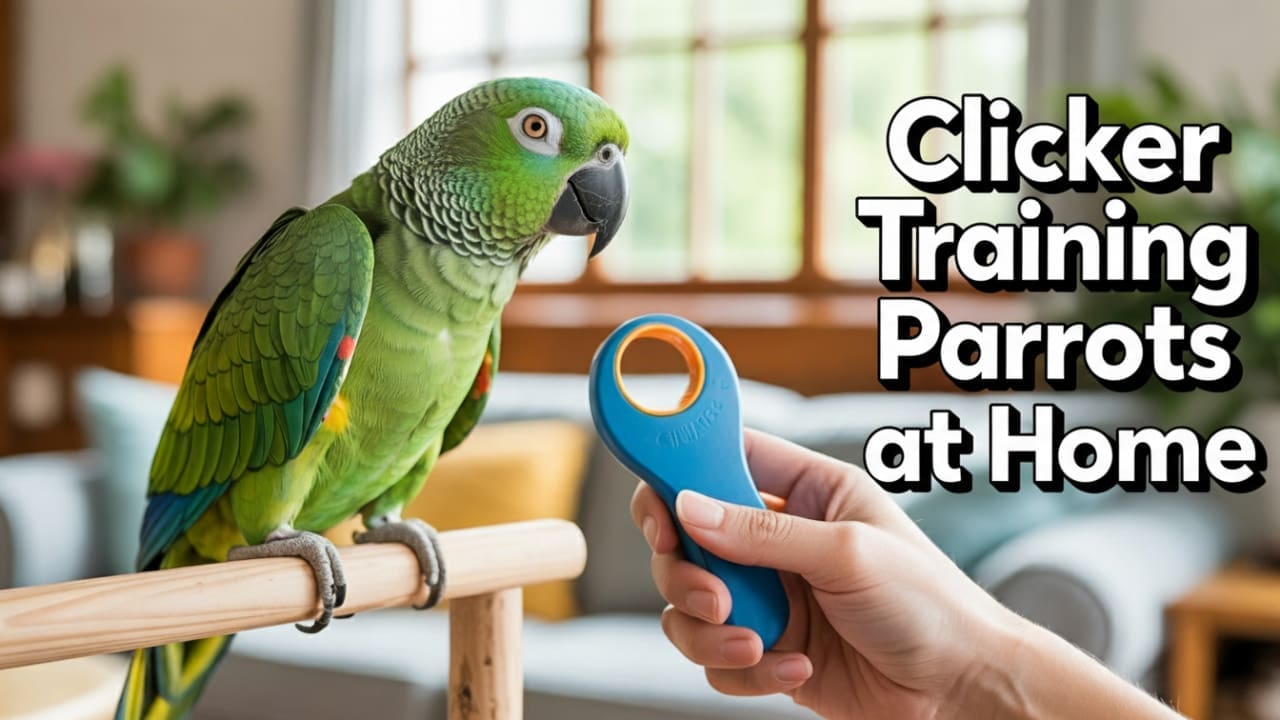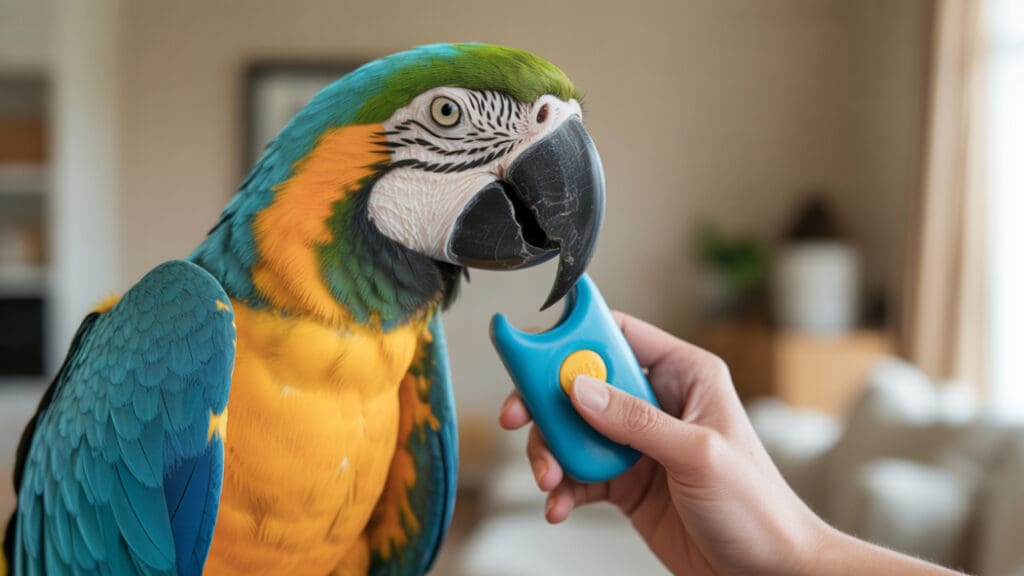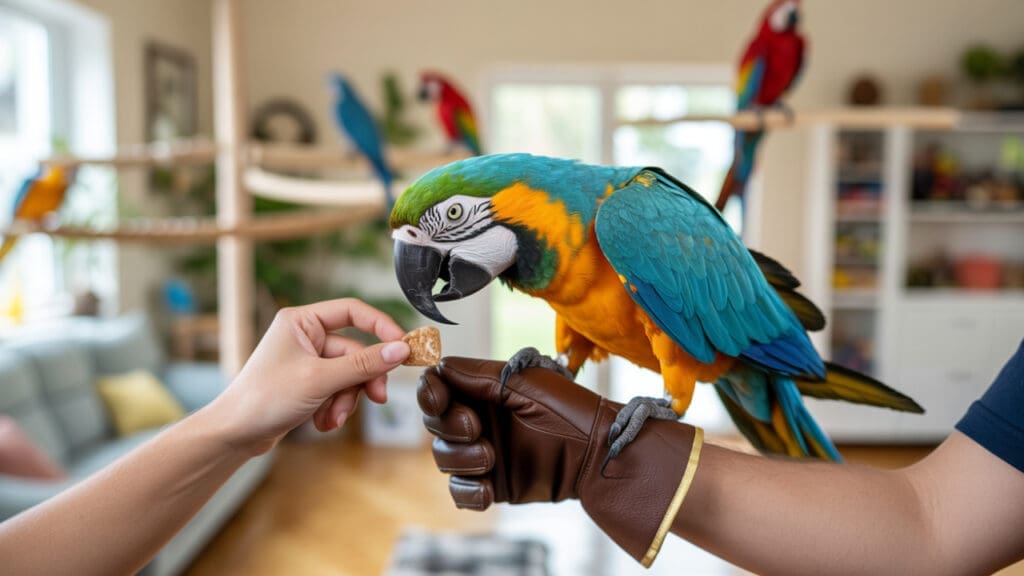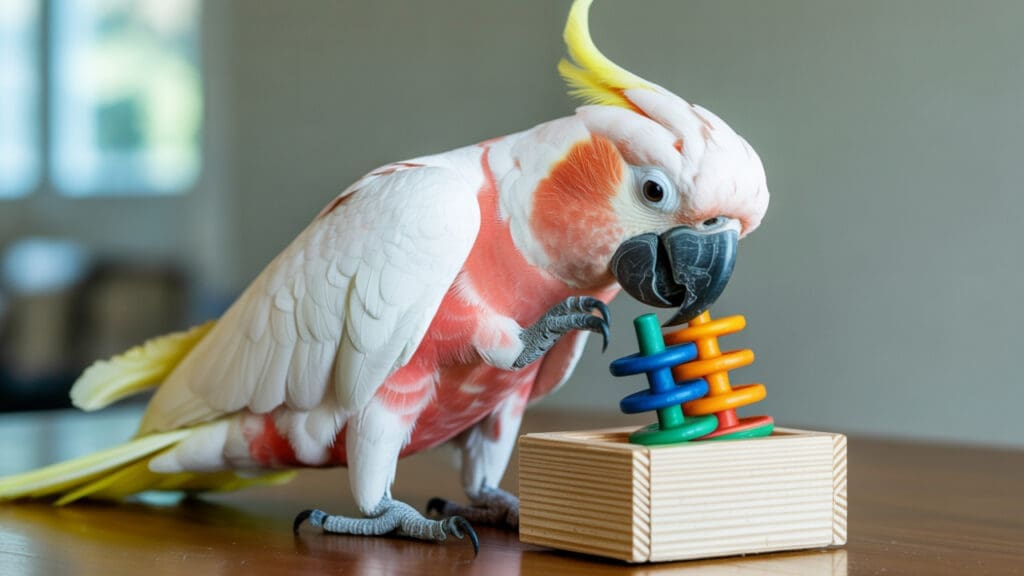
Newsletter Subscribe
Enter your email address below and subscribe to our newsletter

Enter your email address below and subscribe to our newsletter

Now, you might have seen it on the Internet that a parrot can just step into their owner’s hand on command, even doing tricks. Certainly, you wish that for your feathered friend, too. But where or how do you even start?
Clicker training parrots at home is probably one of the best ways to go about this. It’s far more effective than most people realize. And it’s a rather cheap investment, too.
With just a simple device that costs less than $10 (even a pen click works), you can tap into proven behavior science that builds trust between you and your parrot. This can lead to less biting and screaming. And it’ll strengthen the bonds between you two.
Definitely, you’ll need a strategy for clicker training. A good number of owners usually fail because of several reasons. They might have clicked too late, trained their parrots in noisy spaces, or relied too heavily on food rewards. These mistakes can leave your feathered pal confused.
Avian vets say that we’ll need to introduce positive reinforcement clicker training. This is great for teaching your parrot tricks, of course. But it also helps with stress-free grooming, easier vet visits, and your bird’s long-term mental stimulation.
With the right tools, correct timing, and patience, you’ll see why this approach outperforms those outdated punishment-based methods. So, let’s dive in!

Clicker training parrots at home is possibly one of the most effective and humane ways to teach your bird the behaviors you wish to see in them. It can help reduce stress and build trust with your parrot, too.
At its core, clicker training uses a small handheld device that can make a distinct “click” sound. And this should mark the exact moment your parrot performs a desired action. Think of the sound as a bridge between your avian friend’s behavior and a reward (maybe their favorite treat).
If you consistently do this over time, your parrot will learn to associate the click sounds with success. This then makes training both faster and clearer. And what’s best? You might not even need to rely much on verbal cues.
Now, we’ve all done it, and there’s no shame in it. But “bribing” your parrot with food is not exactly the core of this training method. You should ground this in positive reinforcement clicker training, which is a well-researched form of operant conditioning used by animal behaviorists worldwide.
Unlike punishment-based methods, clicker training with positive reinforcement can strengthen the bond between you and your parrot. Most importantly, it promotes confidence in your feathered friend and makes them willing to learn. It’s almost like teaching a human child.
Also, avian vets remark that a good number of parrots trained with consistent reinforcement are less prone to showing anxiety-driven behaviors. These include feather plucking or screaming.
When starting out, you can use a simple target stick, like a wooden dowel or even a chopstick, to guide your parrot’s movement. This can make clicker training with your pet parrot easier and minimize initial confusion.

Perhaps you might have heard some parrot owners or trainers swearing by clicker training. And you should know that it’s for a good reason. The advantages of this method of training are more than just a simple “step up” or wave on command for your avian friend.
As you know, clicker training can strengthen trust and communication between you and your parrots, but that is, if you use positive reinforcement. When the click is clear, the reward is immediate, your feathered animal will learn what you need them to do in no time.
One of the biggest advantages of clicker training is adaptability. This method of training works well for teaching manners. So, you can expect to reduce your bird’s nipping, and you can have them come to you on command.
But what’s more? Clicker training also works well for advanced tricks like fetching small objects or flying to a target. The training further doubles as mental enrichment. And that means you can see a reduction in your pet’s stress level and, of course, anxiety-related behaviors.
That said, experts say that we should not just rely on repetition. Reinforcing your parrot’s correct behavior is just as important. Otherwise, you might slow progress, or worse, unintentionally encourage the wrong behavior.
In any case, know that successful training can really change your daily life with your parrot. For instance, you can train your bird to willingly enter a travel carrier, accept nail trimming, or participate in vet visits. These quality life changes can reduce both your and your bird’s stress.

Before you begin your training session with your parrot, you should have the right tools and environment set up first. Also, know that clicker training techniques are just as important for setting your avian friend up for success.
Having said that, you should be relieved to know that most of the things you need are rather inexpensive, and they are quite easy to source. That means this method is truly accessible to almost every pet parent out there.
A standard clicker is cheap and usually costs less than $10. But you can always substitute with a retractable pen or a distinct tongue click if you feel like cutting down on cost. Just know that you’ll need to be consistent with the sound-sharp, unique, and reliable every time you use it.
But the clicker is not all there is not all there is to the tools you need. Rewards are just as important. Your parrot is more likely to respond when you use high-value treats like sunflower seeds, small pieces of fruit, or favorite pellets.
However, note that vets recommend that we cut treats into tiny portions so that we can prevent overfeeding. After all, frequent reinforcement is the backbone of effective clicker training, so you’ll be feeding your bird a lot. Keep a training pouch or dish nearby so that you don’t need to fumble for food and miss the moment to reward.
The next thing is the setup of your training space. You’ll need to choose a quiet area with close to no distractions. And it should be somewhere your parrot can feel safe. Some of the factors that help your bird focus include perches at a comfortable height, good lighting, and a calm atmosphere.
Don’t make the mistake of trying to train your parrot in a busy room with people moving around. You’ll only have your avian friend’s attention scattered. And that slows progress. Make sure that you have a dedicated “training zone.” It can tell your parrot that the space means a special time of learning and bonding.
Let’s take a step back and consolidate the steps you need to take to successfully clicker train your parrot. Remember, the most important thing is to approach training using a clear, structured process. Each step should be a building block that lays the foundation for the next.
This trick chains several behaviors and is fantastic mental stimulation.
What You’ll Need: A small, bird-safe ball (like a ping pong ball or waffle ball), a clicker, high-value treats.
The Step-by-Step Breakdown:
Target the Ball: Hold the ball. Use your target stick (or finger) and click/treat when your parrot touches the ball with its beak. Repeat 5-10 times.
Shape the Grab: Wait for a harder touch that moves the ball. Click/treat for any interaction that makes the ball roll slightly.
Capture the Hold: The moment your parrot picks up the ball in its beak, CLICK! and offer a treat. To get the treat, they must drop the ball. This is key. Repeat.
Add a Cue: As they consistently pick it up, add the verbal cue “Fetch” just as they go to grab it.
Add Direction: Place the ball a few inches away. Use your target stick to guide them to it and say “Fetch.” Click/treat for success.
Build Distance: Gradually place the ball further away, requiring them to take a step, then a walk, to retrieve it.
Chain it Together: Once reliable, you can chain this with another behavior, like bringing it to your hand.
2025 Safety Note: Always use bird-safe materials. Avoid objects with zinc coatings or small parts that could be swallowed.
Pro Tip (2025): Film your short sessions. Watching the playback helps you spot your timing mistakes and your parrot’s subtle body language cues.
We’ve mentioned that clicker training parrots at home is very effective for getting your pet to show the behaviors you’d like to see in them. But there are myths and misconceptions surrounding this method that discourage owners from giving it a try. Let’s take a closer look at some of these.
One of the most common myths is that clicker training is just bribery. Technically, bribery is something that happens before a behavior. Reinforcement is quite the opposite, as it happens after. The clicker, the click sound, is not exactly a lure. It’s a precise marker, one that only goes off when your parrot does the right thing.
Avian behaviorists say that this distinction is what makes positive reinforcement clicker training so powerful. You don’t rely on showing the treat first. That’s the focus if you do so. Clicker training makes your feathered friend focus on the behavior first, with the expected reward coming after.
The next misconception is that clicker training only works for dogs, not birds. That can’t be further from the truth. Your parrot is very intelligent. And they are social animals with excellent problem-solving skills. So, if that dog can get it, your little friend can, too.
Some people also think that they’ll need to invest in some specialized, expensive tools to make the click sound distinct. But that’s not true. A cheap click of just a few dollars works. And you can even use a pen or tongue click for free. The important thing is timing and consistency, not the device itself.
Lastly, you might think that your parrot will become dependent on treats to do the tricks forever. However, in fact, once a behavior is learned, you can vary the rewards. You can even replace them with praise, scratches, or playtime. They work as rewards.
| Myth | Fact (2025 Avian Science) |
| “Clicker training is just bribing with food.” | FACT: A bribe is shown before to make the bird do something. A clicker reward comes after the right action, helping the bird understand what it did correctly. |
| “It only works for dogs, not intelligent birds.” | FACT: Parrots are very smart and social, which makes them perfect for clicker training. They quickly understand the clear signal a clicker gives. |
| “You need to carry a clicker forever.” | FACT: The clicker is only a teaching tool. Once your bird learns the trick, you can stop using it and switch to words or other rewards. |
| “My bird is too old to learn new tricks.” | FACT: Parrots can keep learning all their lives. Older birds may take a little more time, but they can still learn with patience and practice. |
The last things you should consider are challenges. Sometimes, even with the tools and preparation, clicker training parrots at home might still not go smoothly as you’d hope for. Let’s check out some of the small, correctable issues that might affect the training.
One of the things you need to watch out for is timing. This is very important for creating an association. If your click comes too late or too early, your parrot might think the sound is linked to rewarding a wrong behavior that happened before or after the target behavior.
Avian behavior experts recommend that we practice our timing with a simple exercise. You drop a ball and click the moment it hits the ground. This is to train your reflexes so that you can be more accurate during real training sessions. Remember, don’t just dismiss it as “My bird just isn’t getting it.”
Distraction, too, is a challenge. Never train your parrot in a busy room with people, televisions, or other pets around. It makes it difficult for your little feathered pal to focus. The fix for this is simple. You just need to create a quiet, consistent training space where your bird can feel safe. A spare corner with a stable perch and good lighting works well enough.
The last one is frustration, both you and your parrot. You should know that if a session is too long, your pet may just stop responding. At its worst, you might even see the bird developing some negative associations with the clicker. So, keep the sessions short. Start with just five minutes and end the session positively to prevent you both from burning out.
Remember, challenges can mean opportunities to refine techniques. So, don’t assume setbacks mean failure and dismiss the method. Sometimes, all you need to do is make slight adjustments to time and pacing.
| Problem | Likely Cause | Quick Fix |
| Bird is scared of the clicker sound. | The clicker is too loud or sharp. | Soften the sound by clicking inside your pocket or use a softer clicker (like a pen). You can also say a gentle word like “Good!” at the same time, then slowly switch back to just the clicker. |
| Bird is more interested in the treat cup than training. | The treats are too predictable, or the bird isn’t hungry enough. | Use special treats only for training. Practice before meals instead of after. Keep treats hidden until the exact moment you give them. |
| Progress has stopped; bird won’t try harder steps. | You increased the difficulty too quickly. | Go back one step and make it easier. Follow the “60/40 rule”: 60% easy, known behaviors for confidence, 40% new challenges. |
| Bird gets over-excited and bites after a click. | Frustration from waiting too long for the treat. | Improve your timing. Give the treat within 1–2 seconds after the click. Use small treats that can be eaten quickly. |
Clicker training parrots at home may be effective. But we’re sure you still have some questions and concerns that need addressing. Here are some of the most frequently asked questions that could help clear up confusion and make sure that your training sessions are rewarding for you and your pet.
You’ll need to start the process by pairing the click with a treat. You should gradually get your bird to recognize this simple formula: “click = reward.” So, use the clicker to mark correct behaviors and reinforce them immediately.
This rule is saying that we should dedicate 60% of a session to reinforcing known, correct behaviors and 40% to new skills. This can keep your parrots engaged without overwhelming them.
Some possible downsides include inconsistent timing, overuse of treats, or frustration during long sessions. But you should know that these can all be avoided with short, focused training.
Your parrots can begin as soon as they’re weaned. If your bird is older, however, you might need extra patience and consistency to lead them to success.
It relies on positive reinforcement clicker training. This means the click sound marks the exact behavior you want, immediately followed by a reward. This association can make your parrot learn faster and more clearly.
Positive reinforcement builds trust and encourages repetition of good behaviors. It also avoids the fear or stress that punishment-based methods may cause.
Yes, it’s often used to redirect unwanted actions like biting or screaming into positive alternatives. This leads to your bird being calmer and more cooperative.
No. Once behaviors are established, rewards can shift from food to praise, petting, or play. The results can be kept without lifelong dependency.
Some parrots pick up basic responses in just a few sessions. But you might need weeks of steady practice for more complex tricks.
Many assume that it’s bribery or only effective for dogs. However, this training is a proven, science-based method that works across species, especially intelligent birds like parrots.
Now, you should know that clicker training parrots at home goes beyond teaching tricks to building trust and preventing problem behaviors. This, in turn, makes your everyday care easier.
You don’t need any expensive tools. Just a few dollars’ worth of a clicker plus mastering timing, and you’ll do fine. But remember, avoid the common pitfalls like over-reliance on treats. Know that you’re setting your parrot up for a lifetime of learning and enrichment.
Remember, positive reinforcement creates a calmer, more confident bird. It can transform both simple interactions and advanced applications. Eventually, your effort will likely lead to you having a feathered companion that bites less, is cooperative during vet visits, and engages with you in a fun way.
Take strides today and clicker train that parrot of yours with confidence. Start small, stay consistent, and watch your little friend grow and thrive under your guidance and care.
Have you ever tried clicker training with your parrot? Or want to try perhaps? Share your biggest success or the challenge you’re still working on. Let us know in the comments down below!